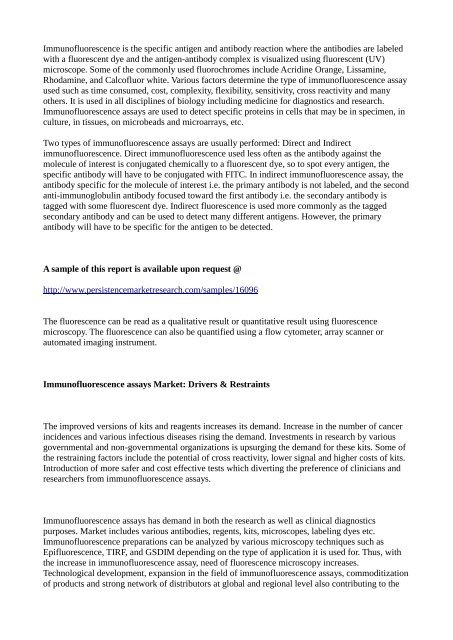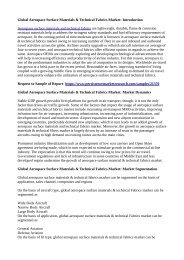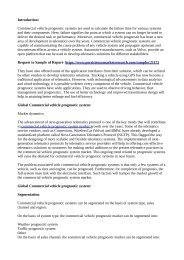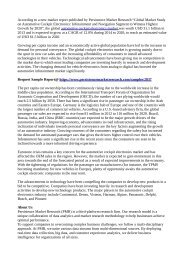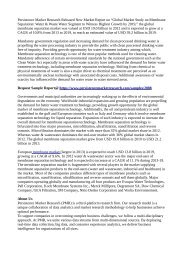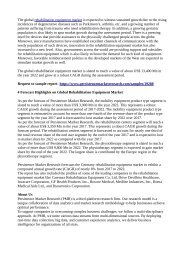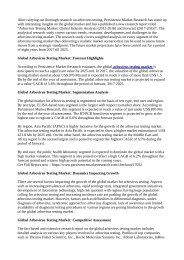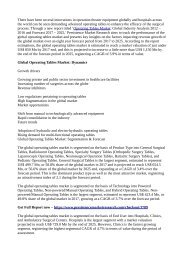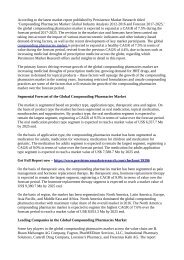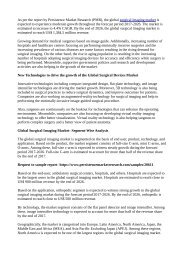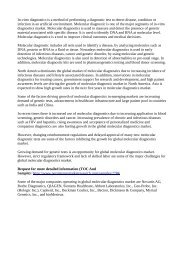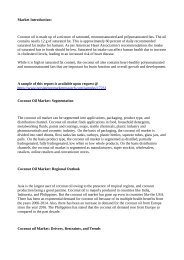Immunofluorescence Assays Market Size will Grow at a Robust Pace through 2025
Immunofluorescence is the specific antigen and antibody reaction where the antibodies are labeled with a fluorescent dye and the antigen-antibody complex is visualized using fluorescent (UV) microscope.
Immunofluorescence is the specific antigen and antibody reaction where the antibodies are labeled with a fluorescent dye and the antigen-antibody complex is visualized using fluorescent (UV) microscope.
Create successful ePaper yourself
Turn your PDF publications into a flip-book with our unique Google optimized e-Paper software.
<strong>Immunofluorescence</strong> is the specific antigen and antibody reaction where the antibodies are labeled<br />
with a fluorescent dye and the antigen-antibody complex is visualized using fluorescent (UV)<br />
microscope. Some of the commonly used fluorochromes include Acridine Orange, Lissamine,<br />
Rhodamine, and Calcofluor white. Various factors determine the type of immunofluorescence assay<br />
used such as time consumed, cost, complexity, flexibility, sensitivity, cross reactivity and many<br />
others. It is used in all disciplines of biology including medicine for diagnostics and research.<br />
<strong>Immunofluorescence</strong> assays are used to detect specific proteins in cells th<strong>at</strong> may be in specimen, in<br />
culture, in tissues, on microbeads and microarrays, etc.<br />
Two types of immunofluorescence assays are usually performed: Direct and Indirect<br />
immunofluorescence. Direct immunofluorescence used less often as the antibody against the<br />
molecule of interest is conjug<strong>at</strong>ed chemically to a fluorescent dye, so to spot every antigen, the<br />
specific antibody <strong>will</strong> have to be conjug<strong>at</strong>ed with FITC. In indirect immunofluorescence assay, the<br />
antibody specific for the molecule of interest i.e. the primary antibody is not labeled, and the second<br />
anti-immunoglobulin antibody focused toward the first antibody i.e. the secondary antibody is<br />
tagged with some fluorescent dye. Indirect fluorescence is used more commonly as the tagged<br />
secondary antibody and can be used to detect many different antigens. However, the primary<br />
antibody <strong>will</strong> have to be specific for the antigen to be detected.<br />
A sample of this report is available upon request @<br />
http://www.persistencemarketresearch.com/samples/16096<br />
The fluorescence can be read as a qualit<strong>at</strong>ive result or quantit<strong>at</strong>ive result using fluorescence<br />
microscopy. The fluorescence can also be quantified using a flow cytometer, array scanner or<br />
autom<strong>at</strong>ed imaging instrument.<br />
<strong>Immunofluorescence</strong> assays <strong>Market</strong>: Drivers & Restraints<br />
The improved versions of kits and reagents increases its demand. Increase in the number of cancer<br />
incidences and various infectious diseases rising the demand. Investments in research by various<br />
governmental and non-governmental organiz<strong>at</strong>ions is upsurging the demand for these kits. Some of<br />
the restraining factors include the potential of cross reactivity, lower signal and higher costs of kits.<br />
Introduction of more safer and cost effective tests which diverting the preference of clinicians and<br />
researchers from immunofluorescence assays.<br />
<strong>Immunofluorescence</strong> assays has demand in both the research as well as clinical diagnostics<br />
purposes. <strong>Market</strong> includes various antibodies, regents, kits, microscopes, labeling dyes etc.<br />
<strong>Immunofluorescence</strong> prepar<strong>at</strong>ions can be analyzed by various microscopy techniques such as<br />
Epifluorescence, TIRF, and GSDIM depending on the type of applic<strong>at</strong>ion it is used for. Thus, with<br />
the increase in immunofluorescence assay, need of fluorescence microscopy increases.<br />
Technological development, expansion in the field of immunofluorescence assays, commoditiz<strong>at</strong>ion<br />
of products and strong network of distributors <strong>at</strong> global and regional level also contributing to the
growth of market.<br />
A geographic condition regarding the <strong>Immunofluorescence</strong> assays market, it has been segmented<br />
into five key regions: North America, L<strong>at</strong>in America, Europe, Asia-Pacific and the Middle East &<br />
Africa. High incidences of chronic and infectious diseases, labor<strong>at</strong>ory autom<strong>at</strong>ion, improved<br />
technology and favorable reimbursement scenario are some of the factors which have led North<br />
America domin<strong>at</strong>ing the immunofluorescence assay market. It is followed by Europe and most of<br />
the market in Germany. Asia Pacific is increasing in the immunofluorescence assay market because<br />
of the increasing number of market players and rising demand of improved products in diagnostics<br />
as well as academic purpose. India, China and Japan are the countries with highest growth r<strong>at</strong>e in<br />
Asia Pacific region and increases the chances of business opportunities in these sectors.<br />
To view TOC of this report is available upon request @<br />
http://www.persistencemarketresearch.com/toc/16096<br />
Some of the global key players in the <strong>Immunofluorescence</strong> assays market for manufacturing kits<br />
and reagents for diagnosis are Thermofischer, Biorad, Universla Biologicals, Perkin Elmer,<br />
Maxvision Biosciences Inc., Euro Diagnostica, Sigma Aldrich and others. Some companies<br />
involves in the fluorescence microscope market includes Olympus lifescience, Leica Microsystems,<br />
EuroImmun AG.
About Us<br />
Persistence <strong>Market</strong> Research (PMR) is a third-pl<strong>at</strong>form research firm. Our research model is a<br />
unique collabor<strong>at</strong>ion of d<strong>at</strong>a analytics and market research methodology to help businesses achieve<br />
optimal performance.<br />
To support companies in overcoming complex business challenges, we follow a multi-disciplinary<br />
approach. At PMR, we unite various d<strong>at</strong>a streams from multi-dimensional sources. By deploying<br />
real-time d<strong>at</strong>a collection, big d<strong>at</strong>a, and customer experience analytics, we deliver business<br />
intelligence for organiz<strong>at</strong>ions of all sizes.<br />
Contact Us<br />
Persistence <strong>Market</strong> Research<br />
305 Broadway<br />
7th Floor, New York City,<br />
NY 10007, United St<strong>at</strong>es,<br />
USA – Canada Toll Free: 800-961-0353<br />
Email: sales@persistencemarketresearch.com<br />
Web: http://www.persistencemarketresearch.com


